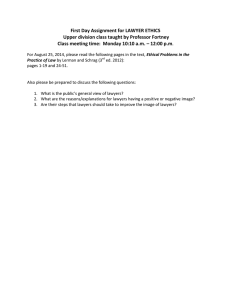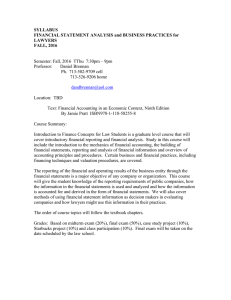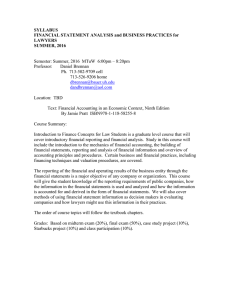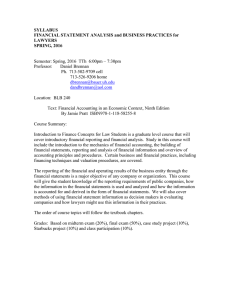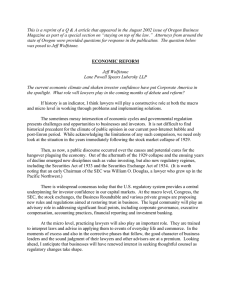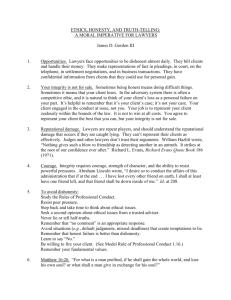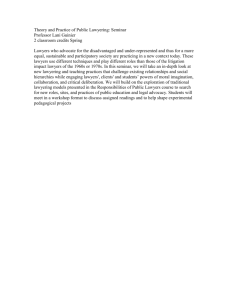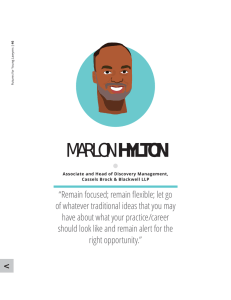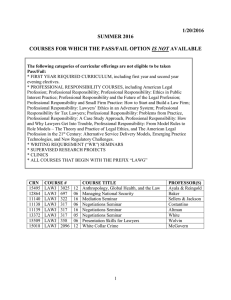Keynote: Law, Lawyers, and the Pursuit of Justice
advertisement
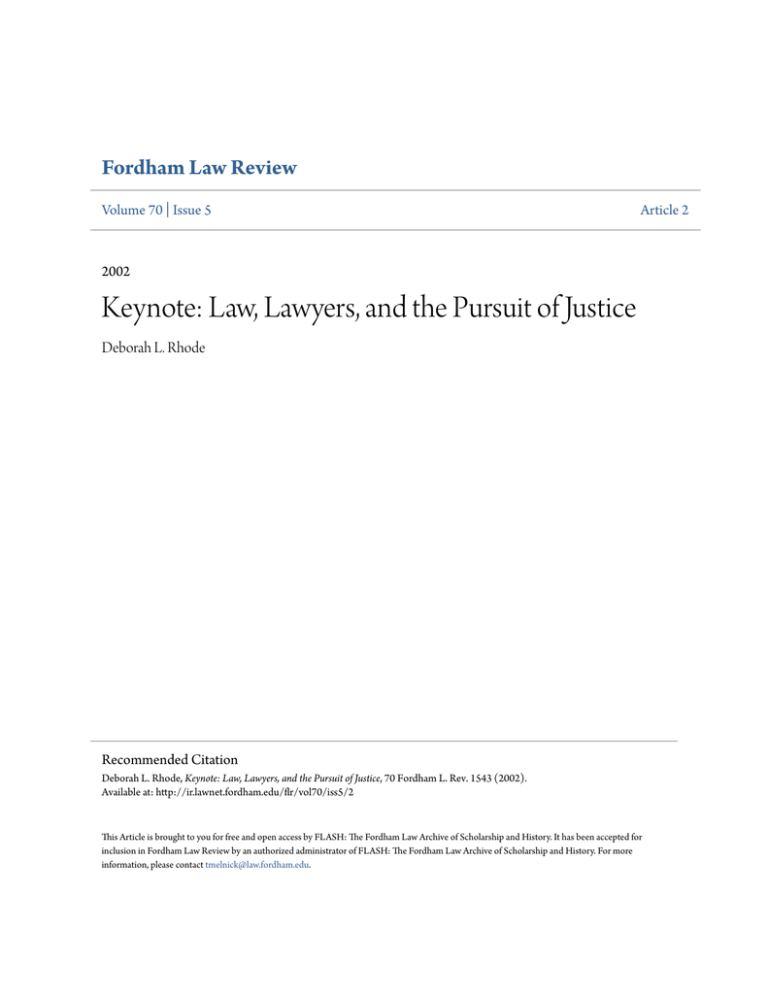
Fordham Law Review Volume 70 | Issue 5 Article 2 2002 Keynote: Law, Lawyers, and the Pursuit of Justice Deborah L. Rhode Recommended Citation Deborah L. Rhode, Keynote: Law, Lawyers, and the Pursuit of Justice, 70 Fordham L. Rev. 1543 (2002). Available at: http://ir.lawnet.fordham.edu/flr/vol70/iss5/2 This Article is brought to you for free and open access by FLASH: The Fordham Law Archive of Scholarship and History. It has been accepted for inclusion in Fordham Law Review by an authorized administrator of FLASH: The Fordham Law Archive of Scholarship and History. For more information, please contact tmelnick@law.fordham.edu. COLLOQUIUM: WHAT DOES IT MEAN TO PRACTICE LAW "IN THE INTERESTS OF JUSTICE" IN THE TWENTY-FIRST CENTURY? KEYNOTE LAW, LAWYERS, AND THE PURSUIT OF JUSTICE Deborah L. Rhode* There are many rewards for a legal academic, but none are greater than this. It is an incomparable honor and pleasure to launch a gathering of leaders in the field around crucial issues for the profession and the public. I am especially touched to be among former professors, students, co-authors, and classmates, as well as colleagues whose work I have so long admired from a distance. My deepest appreciation goes to all who made it possible, especially to John Feerick, Bruce Green, and Russell Pearce. My hope is that our dialogue here will be part of a continuing effort to connect the ideals and institutions of legal practice. Events like these are a testament to our partial progress. Conferences, or even courses, on legal ethics were noticeable for their absence when I went to law school. I graduated a quarter of a century ago without ever having had a class on the subject. If I was instructed by the pervasive method, it left no memorable trace. What is most striking to me now is how little of this was striking to me then. Professional responsibility had a reputation aptly captured by one of the first serious scholars in the field as "general piffle."I That view was reinforced by bar exams. On the rare occasions when ethics questions were included, they asked applicants to reflect on topics like * Ernest W. McFarland Professor of Law and Director, Keck Center on Legal Ethics and the Legal Profession, Stanford University; B.A., Yale (1974), J.D., Yale (1977). This lecture was presented as the Noreen E. McNamara Memorial Lecutre at Fordham University School of Law on November 8,2001. The research assistance of Elizabeth Perel and the reference services of Paul Lomio and Erika Wayne of the Stanford Law Library are gratefully acknowledged. 1. George P. Costigan, Jr., The Teaching of Legal Ethics, 4 Am. L. Sch. Rev. 290, 295 (1917). 1543 1544 FORDHAM LAW REVIEW [Vol. 70 "what the [state's] Code of Professional Responsibility mean[s] to me."'2 It is not clear that anyone actually read the answers. Over the last decades, the legal ethics landscape has been transformed, partly due to the efforts of those represented here. Our field now is a field, and "piffle" is not a term that is likely to be applied to symposia like this. But while much has changed, much has remained the same. We have gained a measure of curricular legitimacy, but our influence is largely limited to a single required course that often remains low on the academic pecking order. Although ethical issues arise in every substantive area of practice, that is not apparent from the core curriculum. My own recent survey of the leading casebooks in subjects outside the field of professional responsibility found that only about two percent of total coverage included any mention of the topic. 3 Only a handful of institutions even aspire to curricular integration and almost none make efforts to monitor its effectiveness.4 Only about ten percent of accredited law schools require pro bono service of students, and almost none impose obligations on faculty.5 Most law students graduate without lawrelated pro bono work as part of their educational experience.6 This marginalization of legal ethics and public service minimizes their significance. Educational priorities are apparent from subtexts as well as texts, and faculty who treat professional responsibility as someone else's responsibility encourage future practitioners to do the same. And many of them do. Of course, here again, the last two decades have witnessed significant improvements, but our progress remains partial. A move toward more enforceable rules of professional conduct, an increase in civil liability actions, and a strengthening of disciplinary agencies have all brought new attention to long-standing 2. Thomas L. Shaffer, Legal Ethics After Babel, 19 Cap. U. L. Rev. 989, 991 (1990). For a history, see Deborah L. Rhode, Ethics by the Pervasive Method, 42 J. Legal Educ. 31, 33-42 (1991). 3. The survey, conducted by Stanford law students Hollie Day and Michelle Warchol, reviewed the leading 44 casebooks in core curricular areas: Civil Procedure, Contracts, Constitutional Law, Corporations, Criminal Law, Criminal Procedure, Evidence, Family Law, Property, Tax, and Torts. 4. See discussion and sources cited in Deborah L. Rhode, The Professional Responsibility of Professors, 51 J. Legal Educ. 157 (2001) [hereinafter Rhode, ProfessionalResponsibility]. 5. Deborah L. Rhode, Cultures of Commitment. Pro Bono for Lawyers and Law Students, 67 Fordham L. Rev. 2415, 2416-17 (1999) [hereinafter Rhode, Cultures]. The amounts demanded are sometimes quite minimal: less than eight hours a year. William B. Powers, Report on Law School ProBono Activities, 28 Syllabus 10 (1995). 6. Rhode, Cultures, supra note 5, at 2417; Powers, supra note 5; Ass'n of Am. Law Schools, Comm'n on Pro Bono and Public Service Opportunities, Learning to Serve, available at http://www.aals.orglprobonolreport.html (last visited Mar. 8, 2002) [hereinafter Learning to Serve]; see Interviews with Focus Groups held in Chicago and San Francisco by the Ass'n of Am. Law Schools Comm'n on Pro Bono and Public Service (1998) (on file with the author). 20021 THE PURSUIT OFJUSTICE 1545 ethical concerns. But as the contributions to this symposium reflect, we remain a considerable distance from justice as either the public or the profession perceives it. About two-thirds of surveyed Americans believe that a lawyer is not a "seeker of justice." 7 Only one-quarter of lawyers find that legal practice has lived up to their expectations in contributing to the social good, and this lack of contribution is the greatest source of career dissatisfaction.8 Yet what exactly would constitute the "practice of law in the interests of justice" is by no means self-evident. In principle, justice is what everyone wants more of. But in practice, what qualifies as justice, how best to achieve it, and who will pay the price remain As Geoffrey Hazard's paper notes, deeply contested issues. discussions that are not embedded in concrete procedural and substantive choices are "unavoidably vacuous," and when we confront these choices, agreement tends to unravel.9 This symposium offers a case in point. Virtually all the contributors begin from a common premise, expressed repeatedly in bar ethical codes, that a lawyer is "a public citizen having special responsibility for the quality of justice."'" But, like other members of the profession, we differ in some significant ways about what that responsibility requires. I cannot do justice to all our differences in my brief remarks, but I can at least clarify my own views, and address some key points of dispute and consensus among these respected colleagues." The book that suggested the theme for this symposium, In the Interests of Justice, makes two central claims. The first is that lawyers, individually and collectively, need to assume greater responsibility for the consequences of their professional actions, for the performance of the legal system, and for the effectiveness of bar regulatory processes. A second, and related claim is that the public needs to demand greater accountability from the profession, and to assume a greater role in overseeing its conduct and the delivery of legal services. This first central challenge for the legal profession is how to strengthen a sense of ethical obligation and how to inspire richer understandings of what it demands in practice. In essence, lawyers 7. Deborah L. Rhode, In the Interests of Justice: Reforming the Legal Profession 4 (2000) [hereinafter Rhode, Interests of Justice]; Gary A. Hengstler, Vox Populi: The Public Perceptionof Lawyers: ABA Poll,A.B.A. J., Sept. 1993, at 60,62. 8. ABA Young Lawyers Div. Surv., Career Satisfaction 19 (2000); ABA Young Lawyers Div. Surv., Career Satisfaction 11 (1995). 9. Geoffrey C. Hazard, Jr., Law and Justice in the Twenty-First Century, 70 Fordham L. Rev. 1739, 1739 (2002). 10. Model Rules of Prof'l Conduct pmbl (2000). For other references to the lawyer's obligations to serve justice, see Model Code of Prof'l Responsibility pmbl (1980) and ABA Canons of Prof'l Ethics pmbl (1956). 11. I respond more fully to criticism in a forthcoming Stanford Law Review symposium on my book, In the Interests of Justice. The point of this lecture is to highlight themes raised by that work and the participants in this symposium concerning the practice of law in pursuit of justice. 1546 FORDHAM LAW REVIEW [Vol. 70 need to assume greater moral responsibility for the consequences of their professional conduct. Those consequences need to be considered against a realistic social backdrop, in which adversarial and lawmaking processes function imperfectly, and not all interests are adequately represented. What constitutes a just result will inevitably be a contextual and subjective decision, but the results should be defensible under disinterested and generalizable principles. Clients' concerns are entitled to deference, but not to the exalted position that they now occupy in the profession's moral universe. Many bar leaders and several contributors to this symposium disagree. Monroe Freedman makes an eloquent claim that the lawyer's central obligation is to "enhance... clients' autonomy as free citizens in a free society.""l Nancy Moore worries that imposing obligations on lawyers to disclose confidential information in order to protect the lives, health, or financial safety of third parties would result in unduly "thin obligation[s] of client loyalty.' 1 3 If, as she notes, private citizens have no comparable disclosure obligations, why 14 should only attorneys be forced to assume them? The answer, I believe, is that lawyers, as officers of the justice system, have a special obligation to pursue justice. That obligation runs first and foremost not to particular clients, but to the rule of law and to the core values of honesty, fairness, and social responsibility that sustain it. David Luban and James Fleming, like other distinguished philosophers, note that individual autonomy does not of itself hold intrinsic value; its importance rests on the other values it fosters, such as personal initiative and social responsibility. 15 If a particular client's objective does little to promote such values or does so only at much greater cost to third parties, then unqualified loyalty is difficult to justify. The difficulties are still greater when the client is not a "free citizen," but a profit-driven corporation, and the victims are individuals whose health, safety, and autonomy are not adequately represented. An ethic of undivided client allegiance under these circumstances has encouraged lawyers' assistance in some of the most socially costly enterprises in recent memory: the distribution of asbestos and Dalkon Shields, the suppression of health information about tobacco, and the financially irresponsible ventures of savings and loan associations. 16 I, 12. Monroe H. Freedman, How Lawyers Act in the Interests of Justice, 70 Fordham L. Rev. 1717, 1727 (2002). 13. Nancy J. Moore, "In the Interests of Justice": Balancing Client Loyalty and the Public Good in the Twenty-First Century, 70 Fordham L. Rev. 1775, 1783 (2002). 14. Id. at 1785-86. 15. See James E. Fleming, The Lawyer as Citizen, 70 Fordham L. Rev. 1699 (2002); David Luban, The Lysistratian Prerogative: A Response to Stephen Pepper, 1986 Am. B. Found. Res. J. 637, 639; see also Joseph Raz, The Morality of Freedom 381 (1986). 16. Rhode, Interests of Justice, supra note 7, at 56-57; sources cited in id. at 226 2002] THE PURSUIT OFJUSTICE 1547 like Sharon Dolovich, William Simon, Fred Zacharias, and others in this symposium, would prefer some "thinner" sense of client loyalty, and, on the rare occasions when a less self-interested group than lawyers is asked, its members strongly agree." If greater disclosure obligations are part of what Thomas Shaffer unattractively labels "coercive regulation," why shouldn't attorneys live with that result? 18 After all, millions of other professionals here and abroad function quite effectively without the sweeping confidentiality protections that most American bar ethics codes provide.' 9 Efforts to strengthen lawyers' sense of personal responsibility are particularly critical in an economic climate that is pushing in a Increased competition within and across different direction. professions has intensified focus on the bottom line and increased pressures to satisfy short-term client interests at the expense of broader values. As the papers by Roger Cramton, Sharon Dolovich, and Thomas Morgan note, a large part of the delay, deception, obfuscation, and obstruction in legal practice seems driven by profit dynamics.' The result, as columnist Art Buchwald once noted, is that "it isn't the bad lawyers who are2 screwing up the justice system in this country-it's the good lawyers." ' In the face of such pressures, some commentators question whether a call for lawyers to assume greater moral responsibility for their actions is likely to do much good. Critics like Thomas Shaffer are skeptical that "misty conventional societal values" will be sufficient to guide attorneys to a path of righteousness.' Ted Schneyer is similarly dubious that attorneys have, or can develop, a coherent vision of legal n.16. 17. William H. Simon, The Practice of Justice (2000); Sharon Dolovich, Ethical Lawyering and the Possibility of Integrity, 70 Fordham L Rev. 1629, 1673-76 (2002); William H. Simon, The Belated Decline of Literalism in ProfessionalResponsibility Doctrine: Soft Deception and the Rule of Law, 70 Fordham L Rev. 1881, 1893-94 (2002); Fred C. Zacharias, Five Lessons for PracticingLaw in the Interests of Justice, 70 Fordham L. Rev. 1939, 1940-41 (2002) [hereinafter Zacharias, Five Lessons]; Fred C. Zacharias, Rethinking Confidentiality, 74 Iowa L Rev. 351 (1989) [hereinafter Zacharias, Rethinking]; Wes Hanson, Lawyers, Lawyers, Lawyers-Reflections on Lawyers: New Polls Hold a Mirrorto the Profession, Ethics: Easier Said than Done (Joseph & Edna Josephson Institute of Ethics, Marins del Rey, Cal.). Dec. 1993, at 34, 42. 18. Thomas L. Shaffer, The Irony of Lawyers' Justice in America, 70 Fordham L Rev. 1857, 1862 (2002). 19. See Rhode, Interests of Justice, supra note 7, at 111; see also sources cited in id. at 235 n.69. 20. Roger C. Cramton, FurtheringJustice by Improving the Adversary System and Making Lawyers More Accountable, 70 Fordham L. Rev. 1599, 1603.04 (2002); Dolovich, supra note 17, at 1680-82; See Thomas D. Morgan, PracticingLaw in the Interests of Justice in the Twenty-First Century, 70 Fordham L Rev. 1793, 1796-97 (2002). 21. Frances Kahn Zemans & Victor G. Rosenblum, The Making of a Public Profession 3 (1981). 22. Shaffer, supra note 18, at 1860. 1548 FORDHAM LAW REVIEW [Vol. 70 practice in the interests of justice.' Ben Zipursky flags ambiguities in the extent and implications of lawyers' responsibility for their clients' conduct.2 4 And Monroe Freedman worries that under a regime giving lawyers more individual discretion "to act on their own principled convictions," many will develop convictions that point in expedient directions. They will "inventively find evasive strategies to help their clients to despoil the environment, to evade taxes, and to defeat" legitimate product liability claims.' But lawyers with those convictions need no help from my proposed framework to justify such conduct. They are doing just fine under the current regime, which exalts client loyalty and autonomy, at least for those who can afford it. My target audience is other lawyers, including the substantial number who attended law school partly out of a commitment to social justice and who regret that their practices have lost that connection.26 Like Roger Cramton, Russell Pearce, Roy Simon, and Fred Zacharias, I believe that many lawyers who are in a position to give influential ethical advice would like to do the right thing and have a sense, however "misty," about what it requires.27 They deserve more support from the organized bar. A framework calling for self-reflective attempts to apply disinterested, generalizable principles may not yield determinate answers, but it is likely to push us closer to justice as most Americans conceive it. In any event, what is the alternative? I certainly do not mean to overstate how much can be accomplished purely through appeal to moral principle. To the contrary, much of my scholarly career, including this most recent book, has focused on structural constraints, organizational dynamics, and institutional reward structures that drive professional conduct. Asking lawyers to assume greater responsibility for the effects of their actions on courts, innocent third parties, and the system of justice generally is only part of the agenda. We also need reforms in formal rules, disciplinary enforcement processes, and civil liability doctrine that will privilege public over professional interests. But given the political obstacles to achieving such reforms, and the inevitable inadequacies in even well-designed regulatory systems, we cannot avoid relying on lawyers' own sense of moral 23. Ted Schneyer, Reforming Law Practice in the Pursuitof Justice: The Perils of Privileging "Public" Over ProfessionalValues, 70 Fordham L. Rev. 1831 (2002). 24. Benjamin Zipursky, Regulation and Responsibility for Lawyers in the TwentyFirst Century, 70 Fordham L. Rev. 1949, 1954-56 (2002). 25. Freedman, supra note 12, at 1726-27. 26. Robert Granfield, Making Elite Lawyers: Visions of Law at Harvard and Beyond (1992); Robert Stover, Making It and Breaking It: The Fate of Public Interest Commitment During Law School (1989); see supra note 8 and accompanying text. 27. Cramton, supra note 20, at 1610; Russell G. Pearce, Model Rule 1.0: Lawyers Are Morally Accountable, 70 Fordham L. Rev. 1805 (2002); Roy D. Simon, Legal Ethics Advisors and the Interests of Justice: Is an Ethics Advisor a Conscience or a CoConspirator?,70 Fordham L. Rev. 1869 (2002); Zacharias, Five Lessons, supra note 17, at 1945. 2002] THE PURSUIT OFJUSTICE 1549 obligation where other oversight mechanisms are lacking. What that obligation entails will, of course, depend on context-on factors such as lawyers' knowledge, involvement, and capacity to avert harm. However, leaders of our profession, as judges, policy-makers, and educators, can supply greater guidance about how responsibility should be exercised under specific circumstances. Not only must attorneys assume greater responsibility for the consequences of their own conduct, they must accept greater accountability for the performance of the system as a whole. Bar leaders like to present America's rule of law as a model for the world, but they routinely overlook how it functions, or fails to function, for the have-nots. For them, the situation is much like the one portrayed in a famous New Yorker cartoon. There, a well-heeled lawyer peers out over his desk and inquires of a slightly shabby client: "You have a pretty good case, Mr. Pitkin. How much justice can you afford?"8 Our profession has done disgracefully little to address the often prohibitive price of social justice. It is a shameful irony that the nation with the world's highest concentration of lawyers meets less than one-fifth of the legal needs of the poor, and routinely leaves middle-income households without a remedy that they can affordV9 Law is least available to those who need it most. Equal access to justice is a ceremonial platitude over courthouse doors, not a policy priority of the organized bar. Nor has our profession developed workable concepts for translating such abstract principles into actual practice. Most bar rhetoric on access to justice implies only a procedural, not a substantive, commitment. Lawyers conveniently assume that more lawyers are what is needed, together with more opportunities for a "day in court."'3 Yet as Carrie Menkel-Meadow reminds us, access to an adversarial process is not necessarily access to justice, particularly in a system where money often matters more than the merits.' Moreover, even from a purely procedural standpoint, we remain at a considerable distance from providing minimal, let alone equal, access to the legal system. Unlike most other industrialized nations, we recognize no right to legal assistance for civil cases and have provided nowhere close to the resources necessary to support one. As the research summarized in my own and Deborah Cantrell's work indicates, federally subsidized legal services are woefully inadequate. 28. This cartoon was published in The New Yorker on December 24, 1973 (emphasis added). 29. See sources cited in Deborah L Rhode, Access to Justice, 69 Fordhamn L Rev. 1785,1785 n.1 (2001) [hereinafter Rhode, Access to Justice]. 30. See Geoffrey C. Hazard, Jr., After Legal Aid is Abolished, 2 J.Inst. for Study Legal Ethics 375, 386 (1999); Stephen L. Pepper, Access to What?, 2 J.Inst. for Study Legal Ethics 269, 272 (1999). 31. Carrie Menkel-Meadow, Practicing "In tie Interests of Justice" in the TwentyFirst Century: PursuingPeace as Justice, 70 Fordham L Rev. 1761, 1762-63 (2002). 1550 FORDHAM LAW REVIEW [Vol. 70 They provide only about eight-dollars per year for those officially classified as poor, and recent estimates suggest that well over ten times that amount would be required to meet the most basic legal needs of low-income Americans.32 Such estimates would run still higher if they also attempted to include the needs of moderate-income individuals who are now priced out of the legal process, or collective concerns such as environmental risks, inhumane prison conditions, or racial segregation. We also have not begun even to calculate, let alone provide, the resources necessary for truly effective assistance for indigent criminal defendants. Bruce Green, Dennis Curtis, and Judith Resnik document in dispiriting detail the vast gap between constitutional rights and social realities in the criminal justice system. 33 The right to counsel is of limited value when lawyers lack the time, resources, training, or incentives to mount an adequate defense. Part of the problem lies in fees and caseloads that are set at ludicrous levels. Hourly rates for out-of-court work are as low as $20 or $25, and 34 ceilings of $1000 or caseloads of 500 felony matters are common. For most court-appointed lawyers, thorough preparation is a quick route to financial ruin. In some states, teenagers selling sodas on the beach do better than court-appointed counsel.35 Even in capital cases, too many defendants end up, as death penalty expert Steven Bright once put it, with counsel who have "never tried a case before and never should again. 3 6 And in high-profile cases, as Judith Maute notes, the interests of justice too often fall by the wayside in lawyers' scramble for status, recognition, and lucrative publication deals. 37 Part of the problem is that the public is grossly misinformed about what the problem is. Most Americans believe that the system coddles 32. Access to Justice Working Group, And Justice For All: Fulfilling the Promise of Access to Civil Justice in California, Report to the State Bar of California 40 (1996) (putting the figure at $3.6 billion); Hazard, supra note 30, at 380 (estimating between $4 and 5 billion). 33. Dennis E. Curtis & Judith Resnik, Grieving Criminal Defense Lawyers, 70 Fordham L. Rev. 1615, 1617-21 (2002); Bruce A. Green, Judicial Rationalizationsfor Rationing Justice:How Sixth Amendment Doctrine Undermines Reform, 70 Fordham L. Rev. 1729 (2002). 34. David Cole, No Equal Justice: Race and Class in the American Justice System 83 (1999); see Stephen B. Bright, Counselfor the Poor: The Death Sentence Not for the Worst Crime but for the Worst Lawyer, 103 Yale L.J. 1835, 1850-54 (1994); Martin Lasden, ForA Fistful, Cal. Law., Nov. 2001, at 28; Michael McWilliams, The Erosion of Indigent Rights: Excessive Caseloads Resulting in Ineffective Counsel for Poor, A.B.A. J., Mar. 1993, at 8, 8; Jane Fritsch & David Rohde, Legal Aid's Last Challenge from an Old Adversary, Giuliani,N.Y. Times, Sept. 9, 2001, at 41 (Metro Section). 35. Jim Dwyer, Peter Neufeld & Barry Scheck, Actual Innocence 188 (2000). 36. Stephen B. Bright, Keep the Hope of Equal Justice Alive, Address at Yale Law School Commencement, May 24, 1999, in Yale Law Report, at 22 (Fall 1999). 37. Judith L. Maute, "In Pursuit of Justice" in High Profile CriminalMatters, 70 Fordham L. Rev. 1745 (2002). 2002] THE PURSUIT OFJUSTICE 1551 criminals and that too many get off on technicalities. 5- News and entertainment media often reinforce these perceptions. In the criminal trials that the public sees, zealous advocacy is the norm. The lawyers for O.J. Simpson and Timothy McVeigh left no stones unturned. But they were charging by the stone, and their performances were on display. In the vast majority of criminal cases, the situation is otherwise. These concerns have not entirely escaped attention among the leaders of the legal profession. But courts and bar associations have too often been part of the problem rather than the solution. An example involves judicial unwillingness to find ineffective assistance of counsel, even where attorneys are drunk, on drugs, or out parking their cars during key parts of the prosecution's case. 9 Defendants have been executed despite their lawyers' lack of any prior trial experience, ignorance of relevant death penalty precedents, or failure to present any mitigating evidence.4 The most systematic survey to date found that over ninety-nine percent of ineffective assistance claims were unsuccessful." The extent of judicial tolerance is well illustrated by the jurisprudence that has developed to determine how much dozing is constitutionally permissible. As one Texas judge put it, "The Constitution says that everyone's entitled to an attorney of their choice. But the Constitution does not say that the lawyer has to be awake."'42 Other courts agree, and some employ a ludicrously detailed three-step analysis: did counsel sleep for repeated and prolonged periods, was counsel actually unconscious, and were crucial defense interests at stake while counsel was asleep.4 3 Not only have courts been reluctant to set aside convictions for ineffective assistance of counsel, neither they nor bar associations have been willing to address the financial and caseload pressures that 38. ABA, Perceptions of the United States Justice System 66 (1999). 39. Bright, supra note 34, at 1843; Cole, supra note 34, at 87; see also Bruce A. Green, Lethal Fiction"The Meaning of "Counsel" in the Sirth Amendment, 78 Iowa L Rev. 433, 499-501 (1993); Stephen J. Schulhofer, Effective Assistance on the Assembly Line, 14 N.Y.U. Rev. L. & Soc. Change 137, 139 (1986); Robert E. Scott & William J. Stuntz, PleaBargainingas Contract,101 Yale L.J. 1909, 1957-58 (1992). 40. See Bright, supra note 34, at 1841-42; Cole, supra note 34, at 87; Green, supra note 39, at 499-501. 41. Victor E. Flango & Patricia McKenna, FederalHabeas Corpus Review of State Court Convictions, 31 Cal. W. L. Rev. 237, 259-60 (1995). For the doctrinal impediments to ineffective assistance claims, see Green, supra note 33. 42. Bruce Shapiro, Sleeping Lawyer Syndrome, The Nation, Apr. 7, 1997, at 27,27 (quoting Judge Doug Shaver's comment during the trial of George McFarland). In its opinion on the appeal of the McFarland case, the Texas Court of Criminal Appeals commented further on attorney napping. McFarland v. State, 928 S.W.2d 482, 506 n.20 (Tex. Crim. App. 1996). For another reference to the dozing lawyer in the McFarlandcase, see Bob Herbert, Cheap Justice, N.Y. Times, Mar. 1, 1998, § 4, at 15. 43. Tippins v. Walker, 77 F.3d 682, 687-90 (2d Cir. 1996); Burdine v. Johnson, 66 F. Supp. 2d 854,863-64 (S.D. Tex. 1999), affd en banc, 262 F.3d 336 (5th Cir. 2001). 1552 FORDHAM LAW REVIEW [Vol. 70 produce it. Challenges to inadequate statutory fees for private attorneys and excessive assignments for public defenders have rarely been successful." One reason is that judges who face crushing caseloads of their own have been reluctant to pay the price of more effective advocacy, which would result in more time-consuming trials and pretrial matters. Bar disciplinary agencies have faced similar disincentives. In the absence of external pressure or volunteer labor like that supplied by Curtis's innovative Yale clinic, underfunded and overcommitted regulatory authorities have done little to facilitate grievances by criminal defendants." Finally, and most disturbingly, both courts and bar associations have failed to address the ways that their own rules and practices obstruct access to justice. On issues like procedural simplification, pro se assistance, and non-lawyer services, courts have been insufficiently proactive, and bar organizations have been actively resistant. In "poor peoples' courts" that handle housing, bankruptcy, small claims, and family matters, parties without lawyers are less the exception than the rule. Yet the systems in which these parties operate have been designed by and for lawyers, and neither courts nor bar associations have pressed for reforms that would make them accessible to the average claimant. Innovative projects and proposals are not in short supply. Examples include procedural simplification, standardized forms, educational materials, self-service centers with interactive kiosks for information and document preparation, free in-person aid from volunteer lawyers or court personnel, and judicial intervention to prevent manifest injustice.46 But a majority of surveyed courts have no formal pro se assistance services, and many of the services that are 44. See, e.g., Frances A. McMorris, Giuliani's Hard Line Breaks Strike at New York City Legal Services, Wall St. J., Oct. 6, 1994, at Bl; see also FTC v. Superior Court Trial Lawyers Ass'n, 493 U.S. 411 (1990) (finding that a boycott by District of Columbia defense attorneys seeking higher compensation constituted an antitrust violation). The efforts continue. See N.Y. County Lawyers' Ass'n. v. Pataki, 727 N.Y.S.2d 851 (Sup. Ct. 2001). 45. Curtis & Resnik, supra note 33, at 1622; see James S. Liebman, The Overproductionof Death, 100 Colum. L. Rev. 2030,2073-78 (2000). 46. ABA Standing Comm. on the Delivery of Legal Services, Responding to the Needs of the Self-Represented Divorce Litigant 12-13 (1994); Mass. Bar Ass'n, Family Law Section Comm. on the Probate and Family Court, Changing the Culture of the Probate and Family Court 29 (1997) [hereinafter Changing the Culture]; Deborah J. Cantrell, Justice for Interests of the Poor: The Problem of Navigating the System Without Counsel, 70 Fordham L. Rev. 1573, 1581-89 (2002); Roger C. Cramton, Delivery of Legal Services to OrdinaryAmericans, 44 Case W. Res. L. Rev. 531, 562-63 (1994); Russell Engler, And Justice ForAll-Including the Unrepresented Poor: Revisiting the Roles of the Judges, Mediators, and Clerks, 67 Fordham L. Rev. 1987, 2049 (1999) [hereinafter Engler, Justice For All]; Jona Goldschmidt, How Are Courts Handling Pro Se Litigants?, 82 Judicature 13, 20-22 (1998) [hereinafter Goldschmidt, Litigants]; Dianne Molvig, Growing Solutions to Unmet Legal Needs, Wis. Law., Aug. 1996, at 10. 2002] THE PURSUIT OFJUSTICE 1553 available are inaccessible to those who need help most: litigants with limited education, financial resources, and English language skills" Part of the problem lies with judges who are reluctant to encourage more individuals to proceed without counsel.a Other courts worry about antagonizing lawyers, whose economic interests are threatened by self-help initiatives and whose support is critical to judges' own effectiveness, election campaigns, and advancement. Similar considerations have worked against efforts to broaden access through non-lawyer providers of legal services. Almost all scholarly experts and bar commissions that have systematically studied the issue have recommended increased opportunities for nonlawyer assistance. Almost all the major judicial decisions and bar associations have ignored those recommendations. 9 I have been chronicling the resistance for almost a quarter century, beginning with my first year in law school in Steve Wizner's legal clinic. It was, for all the reasons that his article describes, a transformative experience. I worked in a poverty law office that was so understaffed and overwhelmed that it accepted new family law cases only one morning a month. When the office attempted to put out a self-help kit that could assist at least some of those turned away, the local bar threatened suit for unauthorized practice of law. It was not the profession's finest hour. The same could be said of the American Bar Association's February 2000 meeting, where the House of Delegates approved a resolution to strengthen, rather than reform, sweeping unauthorized practice prohibitions.50 Bar leaders have long insisted that such prohibitions are motivated solely by concerns to protect the public rather than the profession. But virtually no experts and no other countries share that view. Most nations generally permit non-lawyers to provide assistance on routine matters, and most research finds that these specialists are no less qualified than lawyers to offer such assistance in areas where legal needs are greatest."1 Such findings 47. See sources cited in Rhode, Access to Justice,supra note 29, at 1785 n.1. 48. See Jacobsen v. Filler, 790 F.2d 1362, 1364-65 (9th Cir. 1986); Engler, Justice For All, supra note 46, at 2012-2015; Goldschmidt, Litigants, supra note 46, at 19; Changing the Culture, supra note 46, at 51. 49. For scholars' views, see the sources cited in Deborah L Rhode, Professionalism in Perspective: Alternative Approaches to NonLawyer Practice, 22 N.Y.U. Rev. L. & Soc. Change 701 (1996) [hereinafter Rhode, Professionalism]; Deborah L. Rhode, The Delivery of Legal Services by NonLawyers, 4 Geo. J. Legal Ethics 209 (1990) [hereinafter Rhode, Delivery of Legal Services]. For other experts, see ABA Comm'n on Nonlawyer Practice, Nonlawyer Activity in Law-Related Situations: A Report With Recommendations (1995); Report of the State Bar of California Commission on Legal Technicians (July 1990) [hereinafter California State Bar Commission Report]. 50. Patricia Manson, Target Unauthorized Practice, ABA Urges, Chi. Daily L Bull., Feb. 14,2000, at 1. 51. See Rhode, sources cited in Access to Justice, supra note 29, at 1806 n.123; see 1554 FORDHAM LAW REVIEW [Vol. 70 should come as no surprise. Law schools do not generally teach, and bar exams do not test, the specialized information involved in dealing with those matters. Problems of unqualified or unethical services can be addressed through regulation, not prohibition." A final area of abdication by courts and bar associations involves pro bono service. Proposed requirements have come and gone, but mainly gone.53 Bar codes and state supreme courts have adopted only aspirational standards, coupled in a few jurisdictions with voluntary or mandatory reporting systems. 4 Yet most lawyers have failed to meet these standards. The best available surveys find that a majority provide no significant pro bono assistance to the poor, much less the ABA's recommended fifty hours per year.5 Law is the second highest earning profession in the country, but the bar's average pro bono contribution is under half an hour a week and half a dollar a day. 6 Performance remains pitiful even among the lawyers who could best afford to do more. Less than one-fifth of the nation's 100 most financially successful firms meet the ABA's standard. Over the past decade, when these firms' revenues grew by over fifty percent, their average pro bono hours decreased by one-third.5 8 For many other legal employers, salary wars have pushed compensation levels to new heights, but this affluence has eroded, rather than expanded, support for pro bono programs. 5 9 As Cynthia Fuchs Epstein notes, many firms also In re Unauthorized Practice of Law Rules Proposed by the S.C. Bar, 422 S.E.2d 123, 124-25 (S.C. 1992); California State Bar Commission Report, supra note 49, at 41; Judith Citron, The Citizens' Advice Bureaux: For the Community, By the Community (1989); Herbert Kritzer, Legal Advocacy: Lawyers and Nonlawyers at Work 193-203 (1998); sources cited in id. at 254-56 nn.1-22; Matthew A. Melone, Income Tax Practice and Certified Public Accountants: The Case for a Status Based Exemption From State UnauthorizedPracticeof Law Rules, 11 Akron Tax J. 47 (1995); Robert B. Yegge, Divorce Litigants Without Lawyers, 28 Fam. L. Q. 407, 418 (1994). In the one reported survey of consumer satisfaction, non-lawyers rated higher than lawyers. Rhode, Delivery of Legal Services, supra note 49, at 230-31. 52. For examples of such proposals, see sources cited in Rhode, Professionalism, supra note 49, at 715 nn.57-58; California State Bar Commission Report, supra note 49. 53. See Comm. on Pro Bono and Legal Services, Proposalto Chief Judge Judith Kaye for an Attorney Pro Bono Reporting Requirement, 52 The Rec. of the Ass'n of the Bar of the City of N.Y. 367 (1997); Esther F. Lardent, Mandatory Pro Bono in Civil Cases: The Wrong Answer to the Right Question, 49 Md. L. Rev. 78, 98-99 (1990). 54. See, e.g., Amendments to Rules Regulating the Fla. Bar-1-3.1 and Rules of Judicial Admin.-2.065 (Legal Aid), 630 So. 2d 501, 505 (Fla. 1993). 55. Model Rules of Profl Conduct R. 6.1 (2001). 56. See sources cited in Rhode, Access to Justice, supra note 29, at 1810-11 nn.14052. 57. Aric Press, Eight Minutes, American Lawyer, July 2000, at 13. 58. Id. 59. Mark Hansen, Trickle-away Economics, A.B.A. J., July 2000, at 20, 20; Kate Ackley & Bryan Rund, Pro Bono: Casualty of the Salary Wars?, Legal Times, Apr. 10, 2000, at 1; Anthony Perez Cassino, Skyrocketing Pay and Public Service, N.Y. L.J., Mar. 31, 2000, at 24; Roger Parloff, Too Rich To Give, American Lawyer, Apr. 2000, at 15. 20021 THE PURSUIT OFJUSTICE 1555 that profess commitment to public service fail to institutionalize it in formal policies, resource priorities, and promotion decisions.' This gap between principle and practice is not inevitable. Tanina Rostain movingly describes the recent outpouring of pro bono assistance for victims of the September terrorist attack.,' On ready display are countless acts that reflect all that is best in our profession. But the history of bar involvement in pro bono programs raises questions about whether this kind of commitment can be sustained.P I recall the last time that I heard lawyers' contributions described in glowing terms. It was at a recent state bar association meeting. There, bar leaders directed extensive praise to lawyers who had volunteered during the meeting for a pro bono environmental project. Their contributions were presented as emblematic of the selfless It all sounded quite public spirit that defines our profession. impressive until I discretely asked for details. It turned out that fewer than one-sixth of the lawyers present had sacrificed a few hours of leisure activities such as golf or shopping in order to pick up trash in a local riverside park. The project reflected no ongoing commitment to such public service; the lawyers assembled only every other year when the meeting occurred at that location. On alternative years, when the bar met at an ocean resort, the community service project involved a sandcastle contest, with entrance fees donated to legal aid organizations. The previous summer, that effort had raised slightly over $250. If this is representative of all that is best in our profession, the public might draw a slightly different message from the one that bar leaders intend. A similar distance between formal principles and actual practices is In theory, selfapparent in professional regulatory processes. regulation is said to serve public interests by guaranteeing an expert oversight structure free from government interference.' In practice, however, the process has not sufficiently responded to consumer concerns. The bar dismisses about ninety percent of complaints about 60. Cynthia Fuchs Epstein, Stricture and Structure" The Social and Cultural Context of Pro Bono Work in Wall Street Firms, 70 Fordham L Rev. 1689, 1694-96 (2002). 61. Tanina Rostain, ProfessionalCommitnents in a Changed World, 70 Fordham L. Rev. 1811 (2002). The support came from lawyers outside New York as well. See Sharon Lerman, Lawyers, Like Others, Try to Help, Cal. Bar J., Oct. 2001, at 1. 62- See Deborah L. Rhode, Ethical Perspectives on Legal Practice, 37 Stan. L Rev. 589, 609-10 (1985); Deborah L. Rhode, Why the ABA Bothers: A Functional Perspective on Professional Codes, 59 Tex. L. Rev. 689, 697-99 (1981) [hereinafter Rhode, Why the ABA Bothers]. 63. Model Rules of Prof'l Conduct pmbl (2001); Model Code of Prof'l Responsibility pmbl (1980). See also Nancy Moore's claim that regulatory autonomy serves the public interest, which does not address all the ways it has fallen short, documented in Chapters 4-6 of my book, In the Interests of Justice. See Moore, supra note 13; see also Rhode, Interests of Justice, supra note 7, at 81-183. 1556 FORDHAM LAW REVIEW [Vol. 70 attorneys, and less than two percent result in public sanctions. 64 Most litigation misconduct and ineffective assistance of counsel goes unreported and unremedied.65 The inadequacy of professional oversight structures cannot help but contribute to public distrust; over two-thirds of Americans lack confidence in the integrity of lawyers or in their disciplinary system. 66 Bar initiatives have also failed to respond to attorneys' own dissatisfaction with their professional lives. Commercialism and incivility are increasing; collegiality and collective responsibility are in decline.67 The priority of profits and the resulting sweatshop schedules have squeezed out time for family commitments as well as public service.' Equal opportunity remains an aspiration, not an achievement. Race and gender bias are condemned in principle but often overlooked in practice. 69 No occupation offers greater opportunities for power, money, and status, but lawyers pay the price in other ways: in disproportionate rates of stress, depression, and substance abuse.7" Many have lost connection with the ideals of social justice that first led them to a legal career. There is, in short, some room for improvement. Although a cottage industry of bar committees, conferences, commissions, and centers has focused on this "crisis in professionalism," such efforts have failed to produce the reforms necessary to address it. At the root of the problems is the bar's reluctance to come to terms with what those problems are. Much of the reason involves the lack of accountability for professional norms and oversight structures. Any regulatory system risks being captured and co-opted by the group to be regulated. Such risks are compounded for the legal profession, given the prevalence of lawyers and former lawyers among the officials normally expected to provide oversight of regulatory structures. Although many judicial, administrative, and legislative officials are committed to reform, they 64. See Rhode, Interests of Justice, supra note 7, at 16, 159-61; see also sources cited in id. at 218 n.38, 245-46 nn.41-44. 65. See id. at 159-60, 181-82; see also sources cited in id. at 245 n.40, 250 n.95; Curtis & Resnik, supra note 33, at 1621-22. 66. See Rhode, Interests of Justice, supra note 7, at 4, 158; see also sources cited in id. at 215 n.4, 245 n.38. 67. See id. at 23-37; Morgan, supra note 20, at 1796-99. 68. Deborah L. Rhode, ABA Comm'n on Women in the Profession, Balanced Lives: Changing the Culture of Legal Practice 14 (2001) [hereinafter Balanced Lives]; Rhode, Interests of Justice, supra note 7; Deborah L. Rhode, Balanced Lives for Lawyers, 70 Fordham L. Rev. (forthcoming May 2002). 69. See Rhode, Interests of Justice, supra note 7, at 38-44; see also sources cited in id. at 223-24 n.38-52; ABA Comm'n on Racial and Ethnic Diversity in the Prof., Miles to Go 2000: Progress of Minorities in the Legal Profession (2000); ABA Comm'n on Women in the Prof., The Unfinished Agenda: Women and the Legal Profession 14-22 (2000). 70. See Rhode, Interests of Justice, supra note 7, at 8; see also sources cited in id. at 216 n.17; Balanced Lives, supra note 68, at 29 n.123. 20021 THE PURSUIT OFJUSTICE 1557 have been hobbled by the bar's own economic and political interests, which often push in opposite directions. Judges depend on law;yers' support for their reputation, advancement, and campaign contributions. Constraints of time and resources also work against their review of lawyers' performance or disciplinary processes. So too, most elected officials see little to gain from challenging an interest group as powerful as the organized bar on issues of regulatory reform, especially since consumers have not mobilized around these concerns. The same is true of disciplinary agencies, which depend directly or indirectly on bar support. The result is that regulation of the legal profession has been designed primarily by and for the profession, and too often protects its concerns at the expense of the public. Consumers have not yet found a way to exercise leverage in the process. Yet as William Ralph Inge once observed, "It is useless for the sheep to pass resolutions in favour of vegetarianism, while the wolf remains of a different opinion."'" What, then, is to be done? Carol Seron and Susan Sturm rightly point out that my own work, while long on policy proposals, is short on a strategy for enacting them.- Identifying ways to mobilize the public and build progressive alliances within the profession is a central challenge for all of us who care about the interests of justice. To conclude this lecture and open that conversation, let me suggest just a few promising directions to pursue. As a threshold matter, we should neither overstate nor overlook the value of recasting lawyers' ethical rules in more socially responsible directions. Many bar standards are insufficiently demanding or overly self-protective. They do too little to prevent overrepresentation for clients who can afford it and underrepresentation for those who cannot. Curbing adversarial excesses will require more effective prohibitions on delay, distortion, and deception. For example, lawyers should have obligations to disclose material evidence and confidential information necessary to prevent significant physical or financial injury. That is not to imply that changing rules will, of itself, be sufficient to change conduct. Not all of what is necessary lends itself to enforcement through formal codes. In particular, it seems unrealistic to expect that disciplinary authorities would pursue violations of a rule like the one Russell Pearce proposes, which would hold lawyers personally responsible for the consequences of their professional 71. William Ralph Inge, Patriotism, in Outspoken Essays 42-43 (William Ralph Inge ed., 1919). 72. Carol Seron, Is "In the Interests of Justice" in the Interests of Laiwyers? A Question of Power and Politics,70 Fordham L. Rev. 1849, 1855 (2002); Susan Sturm, Constructing the Practices of Accountabilit, and Professionalism: A Preliminar Comment on "In the Interests of Justice", 70 Fordham L. Rev. 1903, 1903 (2002). 1558 FORDHAM LAW REVIEW [Vol. 70 conduct.73 Such a mandate could, of course, still have symbolic value 4 in expressing professional ideals and socializing new practitioners.1 Richard Abel, however, rightly reminds us that lawyers endlessly revise ethical codes, partly as a substitute for, or a distraction from, constructing effective systems of enforcement. We should be wary about encouraging that trend.75 But a modification in rules can prompt modifications in behavior if it serves as a foundation for disciplinary or civil liability. For example, after Illinois became the first state to impose sanctions on a lawyer for failing to report collegial misconduct to bar authorities, reports by other Illinois attorneys 76 dramatically increased, and far exceeded those in other states. As that illustration suggests, a key priority should be to strengthen enforcement of ethical rules by courts and bar oversight agencies. That, in turn, will require building more structural checks and public accountability into the process. One promising proposal is to place authority for the development and enforcement of ethical standards in an independent regulatory commission. Such a commission could strike a better balance between professional autonomy and accountability than the current system if its members were selected from diverse constituencies by diverse legislative, judicial, and executive officials.77 Consumer regulation experts, public interest organizations, and competing occupations, as well as bar associations, should have a role in that process. Both the profession and the public also need to demand more adequate representation of vulnerable clients, such as indigent criminal defendants. Mobilizing such an alliance is, to be sure, no small task in a culture traditionally more inclined to get tough on criminals than to subsidize their defense.78 Yet neither is the challenge insurmountable. As Curtis and Resnik note, lawyers and judges have a shared stake in maintaining the reputation of the profession and the legitimacy of the justice process. 79 Recent well73. Pearce, supra note 27. 74. Rhode, Why the ABA Bothers, supra note 62. 75. Richard L. Abel, Choosing, Nurturing, Training and Placing Public Interest Law Students, 70 Fordham L. Rev. 1563, 1563 (2002). 76. An example involves ethical rules requiring lawyers to report serious misconduct by other attorneys. Model Rules of Prof'l Conduct R. 8.3 (2001); Model Code of Prof'l Responsibility DR 1-103(B) (1980). These rules are widely violated and almost never enforced. Deborah L. Rhode & David Luban, Legal Ethics 819 (2001). After the Illinois Supreme Court issued the first published decision imposing sanctions on a lawyer solely for failure to report collegial misconduct, compliance in that state dramatically increased. In re Himmel, 533 N.E. 2d 790 (I11.Sup. Ct. 1988); Rhode, Interests of Justice, supra note 7, at 162-63; Rhode & Luban, supra, at 819 n.5; Laura Gatland, The Himmel Effect, A.B.A. J., Apr. 1997, at 24, 24-25; Darryl van Duch, Best Snitches: Illinois Lawyers, Nat'l L.J., Jan. 27, 1997, at Al. 77. For such a proposal see Rhode & Luban, supra note 76, at 825-26; see also Rhode, Interests of Justice, supra note 7, at 162. 78. ABA, Perceptions of the U.S. Justice System 59 (1999). 79. Curtis & Resnik, supra note 33, at 1626. 2002] THE PURSUIT OFJUSTICE 1559 publicized accounts of the frequency of erroneous convictions, slipshod lawyering, and prosecutorial overreaching can compromise public confidence and lay the political foundations for reform. The task remaining is to capitalize on this potential support to secure additional resources and judicial oversight. In jurisdictions that fail to provide sufficient fees for representing indigents, courts need to find constitutional violations and to develop appropriate remedies. Legislatures need to identify additional funding sources that might be politically acceptable to the general public, such as a progressive tax on lawyers' services. In contexts where inadequate resources are not an excuse for inadequate advocacy, attorneys should become more accountable through disciplinary proceedings, malpractice actions, and denials of legal fees.' It is, of course, true that increased regulation and civil liability come at a cost. Benjamin Zipursky reminds us that such efforts for the medical profession offer a model to be avoided.8 ' But in the absence of better empirical data than is now available, we have no basis for assuming that the price of more "defensive" lawyering would be prohibitive, and would significantly restrict access to services. To the contrary, at least some evidence suggests that increased risks of liability have encouraged lawyers to report more collegial misconduct and to institute more effective systems for preventing malpractice. 2 If more lawyers feared being held accountable for negligent representation or for failing to disclose clients' fraudulent or unsafe practices, we might produce benefits for innocent third parties that would more than compensate for any increase in the cost of legal services.83 But as that example suggests, we urgently need better research on how the profession functions in practice, and on the effects of various reform strategies. On too many key issues, our knowledge base is shockingly thin.' We are awash in theory and starved for facts. And that brings me to my final, and for this audience, perhaps my most 80. See Rhode, Interests of Justice, supra note 7, at 161-65, 211-12: Curtis & Resnik, supra note 33. 81. Zipursky, supra note 24, at 1950-52. 82. For reporting misconduct, see supra note 76 and accompanying text. For malpractice, see Rhode, Interests of Justice, supra note 7, at 165-68 (describing impact of Oregon mandatory malpractice insurance system); Anthony E. Davis, Professional LiabilityInsurers as Regulatorsof Law Practice,65 Fordham L. Rev. 209 (1996). 83. Lawyers' involvement in the savings and loan debacle is the most obvious and costly case in point. See Luban, supra note 15; William H. Simon, The Kaye Scholer Affair: The Lawyer's Duty of Candor and the Bar's Temptations of Evasion and Apology, 23 Law & Soc. Inquiry 243 (1998). 84. For discussion of the "knowledge vacuum" on the factors shaping professional norms, see David B. Wilkins, The ProfessionalResponsibility of ProfessionalSchools to Study and Teach About the Profession,49 J. Legal Educ. 76, 80-88 (1999). For the forces inhibiting such research, see Deborah L. Rhode, Legal Scholarship, 115 Harv. L. Rev. 1327. 1560 FORDHAM LAW REVIEW [Vol. 70 immediately relevant point: the need for law schools to become more actively engaged in professional reform. Specialized educational programs, analogous to those in public health, should focus more attention on the cost, regulation, and distribution of legal services. Law schools could support more research of the kind that Yvonne Tamayo, Susan Sturm, and Carol Seron have identified, and that Susan Carle and Cynthia Epstein have been conducting, on pro bono work and social justice initiatives.85 We also need to know more about the relationship between roles, rules, and regulatory structures. Too much professional responsibility scholarship is data-free doctrinal analysis: the functional equivalent of "geology without the rocks."86 Moreover, too little of the work that could be useful in public policy debates is directed toward the public, or to the media that shape popular attitudes and policy agendas. Like other academics, legal ethics scholars write mainly for each other, and in forms that are not accessible to lay audiences. The result is that most Americans are poorly informed on issues involving the regulation of lawyers and access to justice. For example, public opinion surveys reveal widespread misunderstanding about attorneys' disclosure obligations and about the quality and accessibility of legal representation for the poor.87 Yet attempts to educate the public are, for most academics, an unrewarding and unrewarded task. Except for the relatively few scholars with access to the national media, law school professors have inadequate incentives to write for non-legal audiences or to spend significant time assisting journalists who do. Better to produce some "deeply theorized" tome than to risk dismissal as a mere "popularizer."' A significant commitment to professional reform will require an equally significant adjustment in professional reward structures. Faculties need more resources, training, and incentives to pursue time-consuming empirical projects and to address broader audiences. Law schools also need to make more sustained efforts to enlist and equip students to pursue social justice and to lead professional reform 85. Susan D. Carle, Conceptions of Lawyers' Agency in Legal Ethics Scholarship, 70 Fordham L. Rev. 1591 (2002); Epstein, supra note 60; Seron, supra note 72; Sturm, supra note 72, at 1905-06; Yvonne A. Tamayo, Doing Good While Doing Well in the Twenty-First Century: One Cuban's Perspective, 70 Fordham L. Rev. 1913, 1916-19 (2002). 86. Paul Wice, Judges and Lawyers: The Human Side of Justice 16 (1991) (citing Lawrence M. Friedman, quoted in James Willard Hurst, The Growth of American Law 265-66 (1950)). 87. For confidentiality and disclosure obligations, see Zacharias, Rethinking, supra note 17. For perceptions about the poor's right to counsel in civil cases and their ability to find assistance, see sources cited in Rhode, Access to Justice, supra note 29, at 1792. For misperceptions about the ability of criminal defendants to get off on technicalities, see supra note 78 and accompanying text. 88. Steven L. Carter, The Future of the Public Intellectual, The Nation, Feb 12, 2001, at 28: see also Rhode, supra note 84. 2002] THE PURSUIT OFJUSTICE 1561 efforts. Steps in the right direction would be more public interest curricula and legal clinics of the sort described by Rick Abel, Lucie White, Steve Wizner, Dennis Curtis, and Judith Resnik.' But these efforts should supplement, not substitute for, broader institutional change. As Margaret Russell notes, we need more effective strategies for including issues of diversity throughout the curricula.9 The same is true for issues of professional responsibility. Pro bono programs also need to become a higher educational priority. Participation in public service should receive increased financial support and greater recognition in law school admissions processes, student honors programs, and faculty reward structuresY' Educational institutions cannot be value-neutral on questions of value. Silence sends a powerful message, and if Felix Frankfurter was even partly right that "law and lawyers are what the law schools make them," we have much to answer for.92 This is not a modest agenda. But neither is some significant progress beyond our reach. Like many in this symposium, I came to our profession out of a commitment to social justice and social reform. After a quarter century of struggle on issues of professional regulation, I have not lost that commitment, although I have become somewhat more realistic about what stands in the way. At an earlier, less war-weary point in my academic career, I joined many left critics in worrying that incremental reform would just help shore up an unjust structure and divert efforts from fundamental social transformation. Now, as the survivor of countless, fruitless skirmishes in pursuit of transformation, I have become convinced that incremental reform is the only hope, at least in my lifetime. So, pending the revolution, I have become increasingly willing to seize the inch. My recent efforts focus on identifying way stations on the route to justice that may be imperfect but are at least attainable. And I remain convinced that the agenda we are defining here represents realistic aspirations. Lawyers have been at the forefront of every major movement for social justice in American history, and their efforts have been a model throughout the world. The challenge now is 89. Abel, supra note 75; Curtis & Resnik, supra note 33; Lucie White, In the Interests of Justice: A Digression, 70 Fordham L. Rev. 1921 (2002); Stephen Wizner, The Law School Clinic: Legal Education in the Interests of Justice, 70 Fordham L Rev. 1929 (2002). 90. Margaret M. Russell, McLaurin's Seat. The Need for Racial Inclusion in Legal Education,70 Fordham L. Rev. 1825 (2002). 91. Learning to Serve, supra note 6; see also Rhode, Interests of Justice, supra note 7, at 192-96, 200-03; Rhode, Cultures, supra note 5; Rhode, Professional Responsibility, supra note 4. 92. Letter from Felix Frankfurter to Mr. Rosenwald (May 13, 1927), in Rand Jack & Dana Crowley Jack, Moral Vision and Professional Decisions: The Changing Values of Women and Men Lawyers 156 (1989). 1562 FORDHAM LAW REVIEW [Vol. 70 to channel more of that energy toward reform of our own profession and I thank the participants in this symposium for joining that effort.
